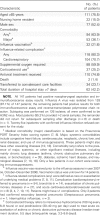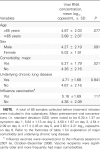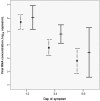Viral loads and duration of viral shedding in adult patients hospitalized with influenza
- PMID: 19591575
- PMCID: PMC7110250
- DOI: 10.1086/600383
Viral loads and duration of viral shedding in adult patients hospitalized with influenza
Abstract
Background: The goal of this study was to characterize viral loads and factors affecting viral clearance in persons with severe influenza.
Methods: This was a 1-year prospective, observational study involving consecutive adults hospitalized with influenza. Nasal and throat swabs were collected at presentation, then daily until 1 week after symptom onset. Real-time reverse-transcriptase polymerase chain reaction to determine viral RNA concentration and virus isolation were performed. Viral RNA concentration was analyzed using multiple linear or logistic regressions or mixed-effect models.
Results: One hundred forty-seven inpatients with influenza A (H3N2) infection were studied (mean age+/-standard deviation, 72+/-16 years). Viral RNA concentration at presentation positively correlated with symptom scores and was significantly higher than that among time-matched outpatients (control subjects). Patients with major comorbidities had high viral RNA concentration even when presenting>2 days after symptom onset (mean+/-standard deviation, 5.06+/-1.85 vs 3.62+/-2.13 log10 copies/mL; P=.005; beta, +0.86 [95% confidence interval, +0.03 to +1.68]). Viral RNA concentration demonstrated a nonlinear decrease with time; 26% of oseltamivir-treated and 57% of untreated patients had RNA detected at 1 week after symptom onset. Oseltamivir started on or before symptom day 4 was independently associated with an accelerated decrease in viral RNA concentration (mean beta [standard error], -1.19 [0.43] and -0.68 [0.33] log10 copies/mL for patients treated on day 1 and days 2-3, respectively; P<.05) and viral RNA clearance at 1 week (odds ratio, 0.10 [95% confidence interval, 0.03-0.35] and 0.30 [0.10-0.90] for patients treated on day 1-2 and day 3-4, respectively). Conversely, major comorbidities and systemic corticosteroid use for asthma or chronic obstructive pulmonary disease exacerbations were associated with slower viral clearance. Viral RNA clearance was associated with a shorter hospital stay (7.0 vs 13.5 days; P=.001).
Conclusion: Patients hospitalized with severe influenza have more active and prolonged viral replication. Weakened host defenses slow viral clearance, whereas antivirals started within the first 4 days of illness enhance viral clearance.
Figures








Comment in
-
Influenza in hospitalized adults: gaining insight into a significant problem.J Infect Dis. 2009 Aug 15;200(4):485-8. doi: 10.1086/600384. J Infect Dis. 2009. PMID: 19591578 No abstract available.
-
Is smoking a risk factor for influenza hospitalization and death?J Infect Dis. 2010 Mar;201(5):794-5. doi: 10.1086/650469. J Infect Dis. 2010. PMID: 20132006 No abstract available.
References
-
- Fiore AE, Shay DK, Haber P, et al. Advisory Committee on Immunization Practices Centers for Disease Control and Prevention Prevention and control of influenza: recommendations of the Advisory Committee on Immunization Practices (ACIP), 2007. MMWR Recomm Rep. 2007;56(RR-6):1–54. - PubMed
-
- Thompson WW, Shay DK, Weintraub E, et al. Mortality associated with influenza and respiratory syncytial virus in the United States. JAMA. 2003;289:179–86. - PubMed
-
- Wong CM, Chan KP, Hedley AJ, Peiris JSM. Influenza-associated mortality in Hong Kong. Clin Infect Dis. 2004;39:1611–7. - PubMed
-
- Yap FH, Ho PL, Lam KF, Chan PK, Cheng YH. Excess hospital admissions for pneumonia, chronic obstructive pulmonary disease, and heart failure during influenza seasons in Hong Kong. J Med Virol. 2004;73:617–23. - PubMed
Publication types
MeSH terms
Substances
LinkOut - more resources
Full Text Sources
Other Literature Sources
Medical

